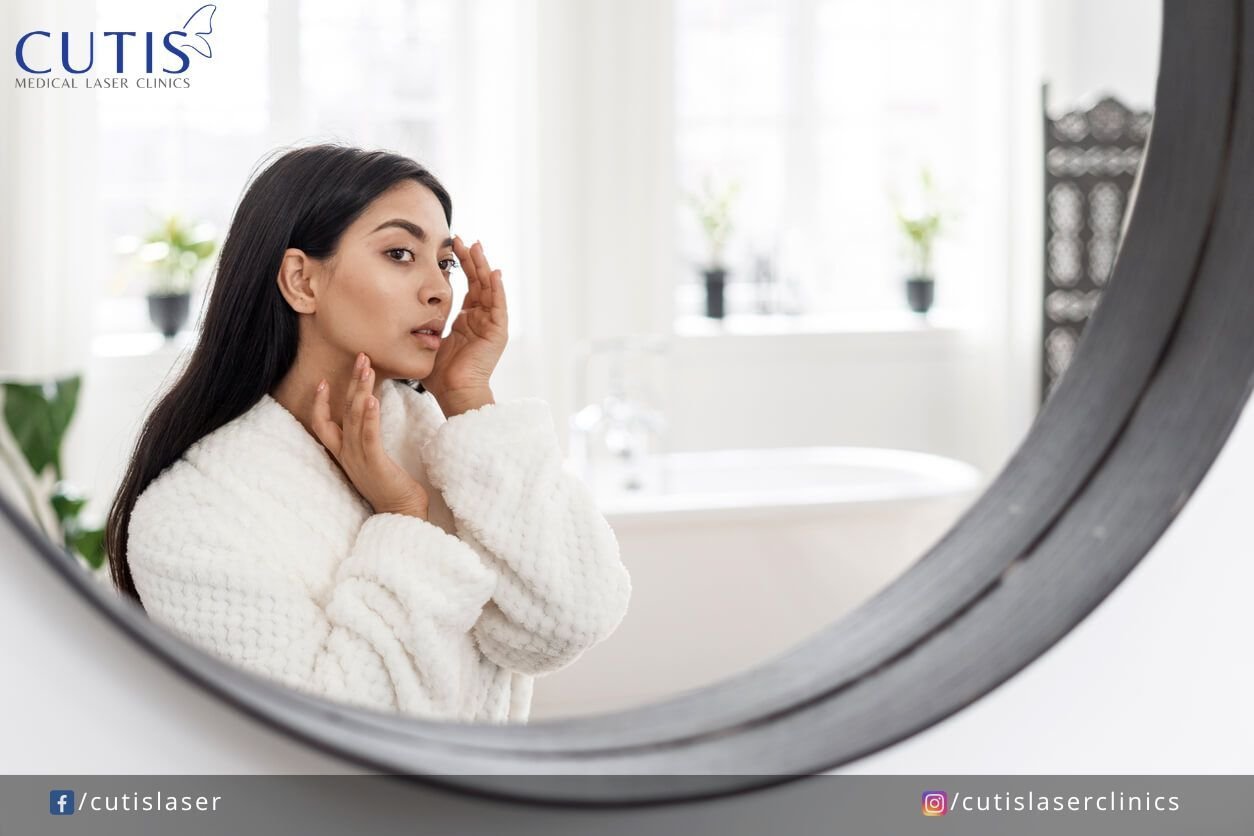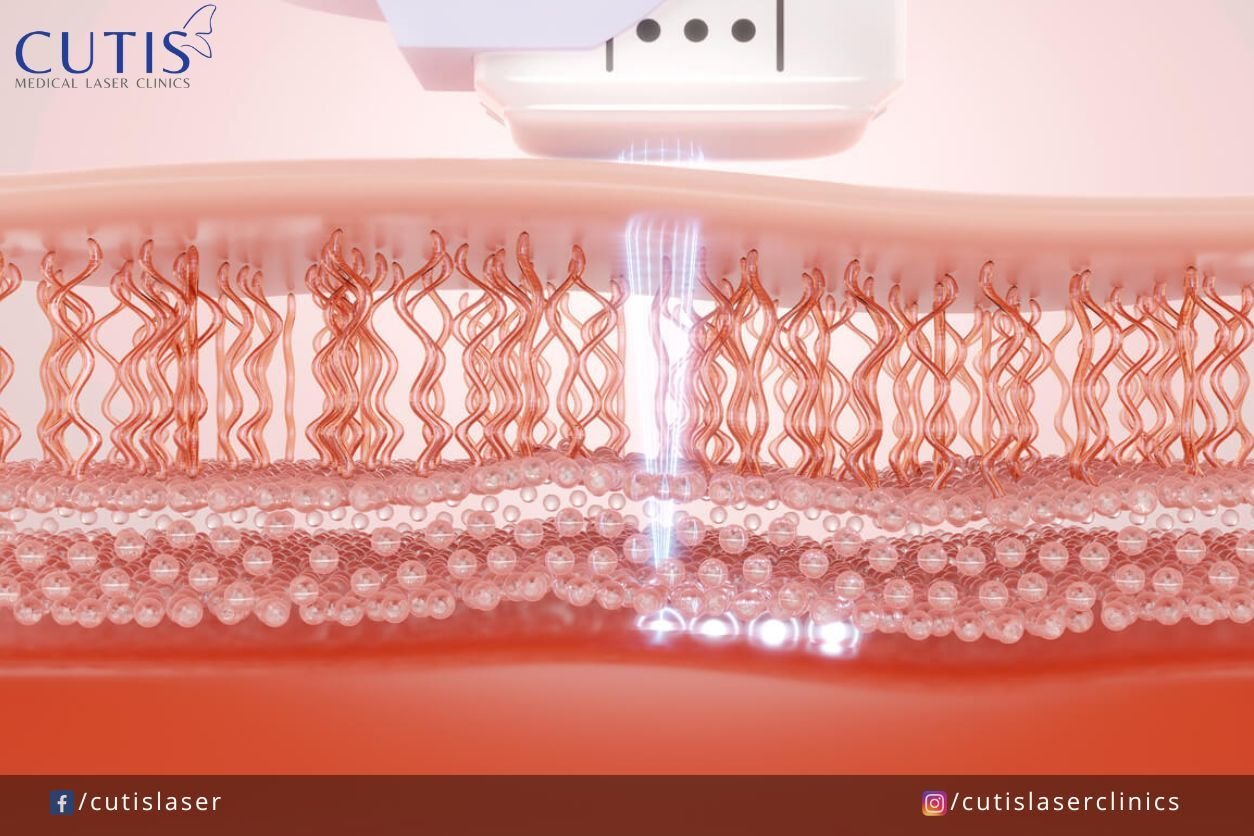
Collagen loss is a major contributor to visible skin aging. As we age, our bodies produce less of this essential protein, which is responsible for maintaining skin firmness, elasticity, and structure. Combined with the degradation of existing collagen, this decline leads to common signs of aging such as wrinkles and sagging skin. Factors such as smoking, sun exposure, and hormonal changes can also speed up this process.
This is why taking care of your skin goes beyond topical products. Enter collagen banking, a skincare trend/proactive strategy that focuses on stimulating your body’s natural collagen production. It is about investing in your skin’s long-term health, helping it stay firm, supple, and youthful over time.
Continue reading as we break down what it really is and answer the most common questions about collagen banking in Singapore and how our team at Cutis can support your journey to healthy, youthful-looking skin.
But first, what is collagen?
Collagen is a naturally occurring protein made from amino acids and found in the connective tissues. It is a major building block of skin, bones, muscles, and other tissues, and is responsible for providing strength, structure, and support throughout the body. Collagen is also the most abundant protein in the body, accounting for 30% of the body’s total protein.
Here are some fast facts about collagen:
- There are 28 types of collagen, with each performing different functions.
- Collagen also contributes to the health and strength of hair and nails.
- Collagen plays a significant role in maintaining skin elasticity, joint health, and bone density.
- Type 1 collagen (provides structure to skin, bones, tendons) makes up 90% of the body’s collagen.
- Type 1 collagen (on a weight-for-weight basis) is stronger than steel.
As previously mentioned, aging and other factors cause a decline in the body’s natural collagen production, at a rate of 1% per year after 30 years old. This can potentially lead to signs of aging (fine lines, wrinkles, and sagging skin), as well as joint pain and decreased bone density.

What is collagen banking?
Collagen banking is a skincare trend gaining a lot of popularity this year. As previously stated, it focuses on preserving and boosting your skin’s collagen to keep the skin youthful over the long term. Instead of addressing collagen loss as it happens, collagen banking prompts you to be proactive, helping you build collagen from within.
It is more about thinking about your skin like a bank or savings account. But rather than cash or money, you are depositing an essential skin protein that helps keep your skin looking healthy and youthful.
This trend/strategy involves collagen treatments that stimulate collagen production, paired with healthy lifestyle habits. These “collagen deposits” are said to assist in maintaining collagen, as the production of this skin protein naturally depletes over time.
When should you start collagen banking?
The mid-20s to early 30s is considered the ideal time to start, as this is when collagen production naturally declines. It is, however, never too late to start enhancing your collagen levels, whether you’re in your 40s, 50s, or beyond. The key is being proactive and taking the steps you can to support your collagen production.
Do take note that the idea behind collagen banking is NOT to refill your collagen stores, so you can have a permanent reserve. It is more about stimulating your natural collagen production early on while your body can still efficiently produce it. Instead of permanently replenishing collagen, it focuses on maintaining healthy levels for as long as possible.

How to bank collagen
There are a number of ways to bank collagen, involving skincare and aesthetic treatments. At Cutis Medical Laser Clinics in Singapore, we have several non-surgical procedures that can help stimulate collagen production. Popular treatments include:
- Ultherapy PRIME – this revamped version of Ultherapy uses microfocused ultrasound with visualization (MFU-V) to gently heat the skin at multiple depths and stimulate collagen. It delivers a lift through real-time imaging that enables doctors to see the layers they are targeting and tailor the treatment for you.
At Cutis, we offer Ultherapy in Singapore using the SPT or See, Plan, Treat Protocol. This involves the use of real-time imaging to gather data and visualize the skin’s anatomy (See) to tailor the ideal course treatment depending on the skin’s unique needs (Plan), and deliver the MFU energy to where it will be most beneficial (Treat).
This procedure provides a non-surgical lifting of the skin on the brow, neck, chin, and décolletage. Most patients require one treatment to achieve desired results, but this can still vary depending on your goals and severity of skin concerns.
- Bio-remodeling injectable – is made with 100% hyaluronic acid and referred to as an “injectable moisturizer”. It features a unique formulation that bio-stimulates collagen, elastin, and proliferates fat stem cells. It gradually releases hyaluronic acid (HA) for 28 days, providing hydration, lifting, and firming effects.
Bio-remodeling in Singapore stimulates four types of collagen (types I, III, IV, VII) and elastin production. It can rejuvenate the face, neck, and decolletage, as well as the hands, chest, knees, and acne scars. It enhances skin hydration, reduces fine lines and wrinkles, and provides a dewy, glowing complexion.
- PDLLA – is a hybrid collagen booster that combines poly D, L-Lactic acid (PDLLA) and hyaluronic acid (HA). PDLLA works as a scaffold to stimulate fibroblasts to produce new collagen. Along with HA, it provides collagen stimulation and hydration to leave your skin looking healthier and more youthful.
PDLLA in Singapore improves skin laxity, wrinkles, and fine lines, with natural looking results and gradual improvements. It can also help with dullness and dryness, acne scars, under-eye hollowing, and skin firming. It is designed to last up to 24 months, which is longer than traditional HA fillers.
Other ways to bank collagen
- Energy-based treatments – Ultherapy in Singapore is not the only energy-based treatments that can help stimulate collagen. There are other non-invasive procedures too that use radiofrequency, ultrasound, lasers, muscle stimulation, or a combination of energies to heat the deeper layers and stimulate collagen.
- Skincare – This involves incorporating products that help boost collagen production. Products with retinol, peptides, HA, and vitamin C can protect the skin and assist with stimulating collagen, while also improving skin texture and reducing the appearance of fine lines and wrinkles.
- Daily sunscreen – Prolonged and unprotected sun exposure can deplete collagen levels. Regular use of broad-spectrum sunscreen creates a physical defense that protects your skin from UVA and UVB rays, which damage your collagen and skin.
Are you ready to start?
Collagen decline is a natural part of aging, but there are things you can do to help slow down the process and potentially boost your collagen production. We at Cutis can help with our non-surgical treatments and product recommendations. Book your consultation with one of our aesthetic doctors and begin the journey toward joyful, graceful aging.
To share, click on the Icon.
